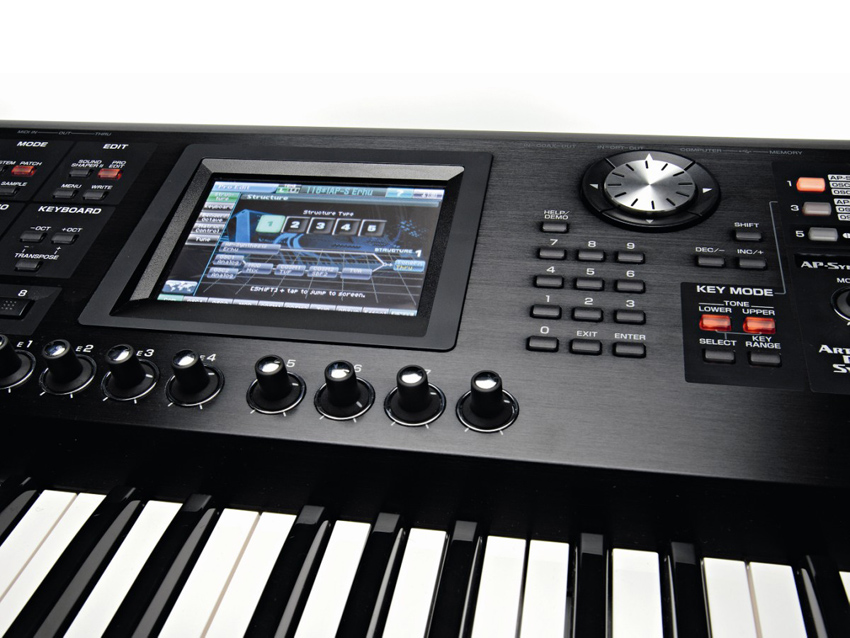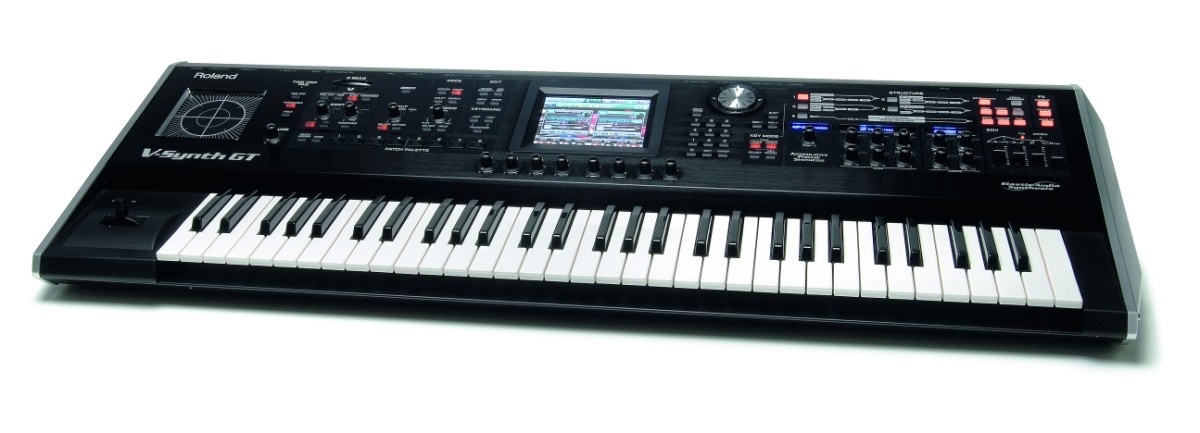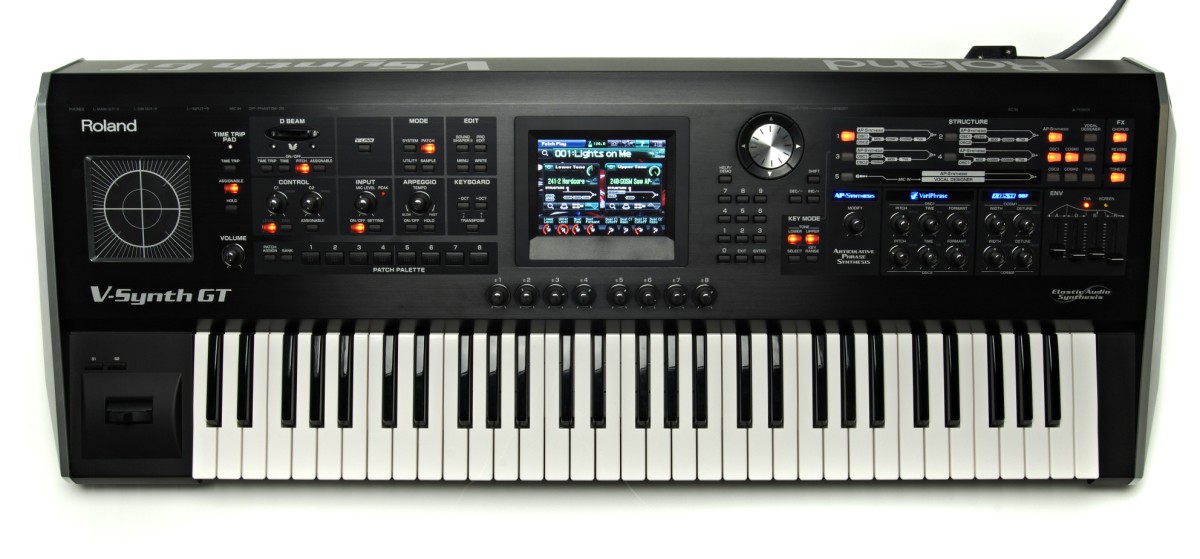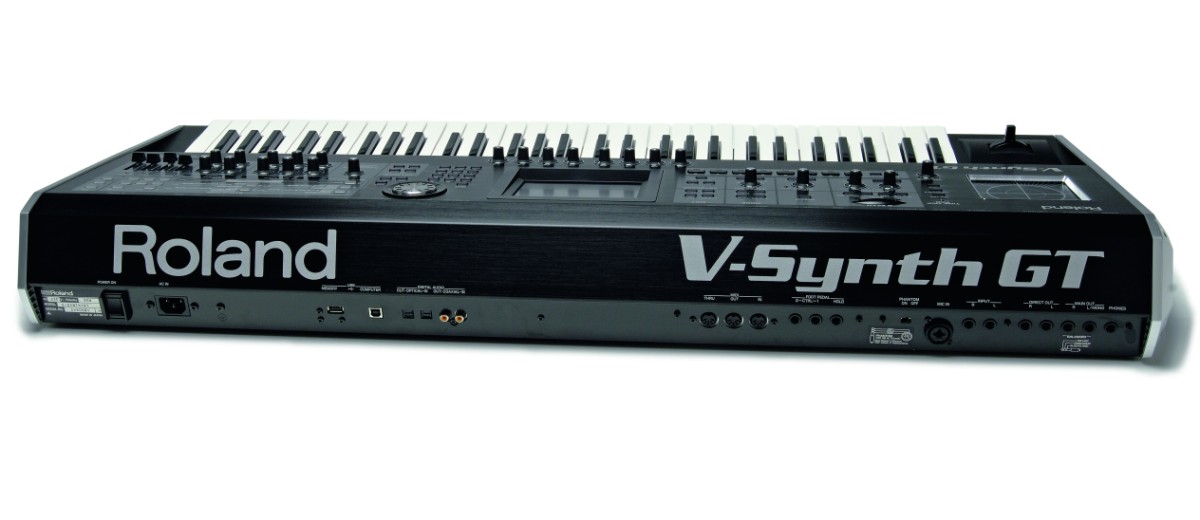MusicRadar Verdict
More power than ever to create, explore and abuse sounds in its own unique way.
Pros
- +
Good value. Very intuitive. Time Trip touch pad.
Cons
- -
Lack of response from the editing knobs.
MusicRadar's got your back




The original V-Synth landed back in 2003 and was heralded as Roland´s most advanced synthesizer yet. That was certainly true, as its arsenal included analogue modelling, PCM waveforms, COSM effects and of course vari-phrase sampling. All in all, a fine selection of sound-shaping tools. Since then we´ve seen the XT rack version, and a pair of expansion cards to bolster the firepower, the D50 emulation and the Vocal Designer.
They say the more we get, the more we want, and this is certainly the case with the V-Synth. Roland are happy to oblige with the arrival of the GT. Like much of the current computer CPU technology, Roland have increased the power by going the ‘dual core´ route, namely putting two synth engines under the hood.
In a simple world, it´s a lot like having two regular V-Synths in one keyboard. But there are some important differences that seasoned users will pick up on, such as the redesigned operating system, built-in Vocal Designer and the brand-new Articulative Phrase Synthesis section. This feature allows users to program patches using parameters based on the expressive qualities of acoustic instruments including violin and sax.
Hardware heaven
The hardware design has been revised to accommodate the extra buttons and controllers needed for the dual synth engines. It retains the high standards set by its predecessors with a solid build and classy finish worthy of a top-flight instrument. It has a full compliment of knobs, dials and sliders, as well as Roland´s exclusive D-Beam controller and Time Trip touch pad for exploring sounds. The V-Synth has always been as much of a performer´s instrument as it has a sound designer´s tool.
The colour touchscreen sits it the central position and a row of eight editing dials are positioned below it. These dials are mapped to the main parameters such as the filter´s cut-off and so on, but they don´t have the kind of lightning-fast response on the sound that we´d expect. It can take the audio as much as a quarter of a second to catch up with the movement, with audible stepping.
This means that they´re not very good for performing with, and since they don´t kick out any MIDI information (neither do the envelope sliders) they´re not much use for sequencing either. There are a couple of assignable knobs that do behave well, and these (along with the D-Beam and TT pad) are highly configurable for controlling the synth, and can also be assigned to send any MIDI CC numbers from the global system menu.
Roll your own
The two ‘cores´ are referred to as the upper and lower tone on the keyboard and can be split into zones or layered in a mix and match way. The combination of both is called a patch.
The review model came loaded with just over 300 patches covering the complete spectrum from basic bread and butter analogue sounds, to complex futuristic soundscapes and back to acoustic emulations at the other end.
Some of these are spectacular and are programmed to show off the interaction and sound mangling potential of the machine with the controllers. Since a patch is a combination of both cores (or tones), they can be very dense with as many as six oscillator layers sounding. But the V-Synth is much more about creating sounds, so let´s take a look at how this works.
The starting point is to choose one of the five types of structure. These are just variations on the oscillators' signal path and the way in which the two COSM effect blocks are used, along with the TVA amp envelope. It´s important at this point to differentiate that the GT has only one master FX section that´s shared by both cores and not one for each core, as might be expected by some. Two oscillators can be used in a tone, and there´s a big choice of analogue models with some of Roland´s favourites including Junos, and Supersaws. Alternately PCM waveforms can be used as well as user samples and ones that have been encoded using the vari-phrase technology. Things can get very complex, very fast and this is down to the fact that each oscillator has its own collection of envelopes and LFO.
One thing they don´t have though is filters as standard, which is where the COSM effects make their entrance. Two are available per tone, and it´s not just your regular multi-node filters on offer.
There´s plenty of potential to explore here including resonators, overdrive, waveshaper, compressors and much more, and we especially liked the unusual qualities of the sideband filters.
Next: the modulator mix, which pits the oscillators against each other using FM, ring and sync techniques. The results get fed into a master amp where they´re joined by the Articulative Phrase Synthesis section.
Keeping it real
This is one of the new features, and exclusive to the GT model setting it apart from the XT and the original versions. The concept behind AP-Synthesis is to apply the, “behavioural model of specific acoustic instruments to synthesizer sounds, thus creating new synth sounds that are overflowing with living expression.”
If that explanation doesn´t make it blindingly clear to you, then join the club! A simple example goes something like this: imagine being able to play a sawtooth waveform with the same articulations as a violin player. You could bow or pluck the waveform for variation, apply vibrato and glide the note in various ways.
To this end, AP-S patches are based on one of 38 preset configurations. These combines a single waveform (which is used as the oscillator) with one or more of the five ‘phrase models´. Each of the phrase models has a different set of parameters based on performance style of the instrument. So wind instruments have breath and slur characteristics, while bowed instruments have qualities like bow scrape and pizzicato. This can be seen as a fast route to programming realistic instrument emulations, and with all controllers ready for mapping, it extends the V-Synth´s potential as a powerhouse-performer´s instrument.
Does it sound any good though? There are some really good examples; one of the better patches was the tenor saxophone, which captured the nuances of subtle breath (which wasn´t just a bit of white noise in the mix) and a tone that evolves from smooth to raspy.
AP-S can be used in conjunction with the synth engine in any of the structure options and doesn´t require its own core. But the limitation of AP-S is that it can´t be routed through any of the two COSM processors for mangling, but it can make full use of the master FX section just like the other oscillators.
Stretching out
Vari-phrase sampling is a big part of the V-Synth´s personality. This is the process that allows audio files to be pitch shifted and time-stretched in real time and coined the term ‘elastic audio´. We take this for granted because of software like Acid and Ableton Live, but this is one of the only hardware alternatives that does the job properly. Audio files must be encoded by the V-Synth so that they can be manipulated using the vari-phrase parameters of pitch, time and formant shifting.
Once done, they can be included in any patch and played with true elasticity. One of the most amazing aspects comes from using the Time Trip pad to play the sounds backwards and forwards and freezing the audio at any point. Try doing that in Ableton with a mouse.
Is more really more?
The GT is undeniably a step in the right direction. It´s more powerful all round, with more of everything, and some new tricks including AP-Synthesis. There´s also the convenience factor of not having to reboot the machine to use the Vocal Designer, but there´s no option to fit expansion cards such as the D50 emulation, which has been popular with XT owners. It´s not clear what Roland are planning on this front, but they might have a surprise or two up their sleeves.
Could I have a moan about something? I´d like it if the eight editing knobs responded better, and that more of the keyboard´s control surface transmitted MIDI data for recording. That kind of stuff seems pretty basic to me, but apparently not to Roland.
Some critics have moaned that the 28-voice (max) polyphony for each core is a bit low, but in the real world, this is more than enough to cover an eight-note chord.
After all, it´s only one sound we´re talking about, not a 16-part multi-timbral workstation. Value-wise, it´s probably the cheapest V-Synth yet, considering that you get twice as much firepower for less than the price of one original model back in 2003. The GT is very intuitive to program and perform with, and contains even more sound mangling potential than before. It´s a very unique experience and offers a powerful alternative to virtual analogues for creating new and exciting sounds.
MusicRadar is the number 1 website for music makers of all kinds, be they guitarists, drummers, keyboard players, djs or producers...
GEAR: We help musicians find the best gear with top-ranking gear round-ups and high- quality, authoritative reviews by a wide team of highly experienced experts.
TIPS: We also provide tuition, from bite-sized tips to advanced work-outs and guidance from recognised musicians and stars.
STARS: We talk to musicians and stars about their creative processes, and the nuts and bolts of their gear and technique. We give fans an insight into the actual craft of music making that no other music website can.
“Every note counts and fits perfectly”: Kirk Hammett names his best Metallica solo – and no, it’s not One or Master Of Puppets
Ranked: Bon Iver's albums, from Sable, Fable to For Emma, Forever Ago
“Its mission is simple: unleash the power of any amplifier or line-level source without compromise”: Two Notes promises a “watershed” in tube amp control with the Torpedo Reload II










